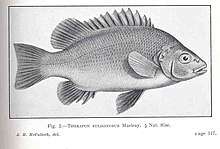Sooty grunter
The sooty grunter (Hephaestus fuliginosus), also known by the name black bream, blubberlips, Northern grunter or purple grunter, is a species of freshwater ray-finned fish, a grunter from the family Terapontidae. It inhabits coastal and inland freshwater creeks and rivers of northern Australia.
| Sooty grunter | |
|---|---|
 | |
| Scientific classification | |
| Kingdom: | Animalia |
| Phylum: | Chordata |
| Class: | Actinopterygii |
| Order: | Perciformes |
| Family: | Terapontidae |
| Genus: | Hephaestus |
| Species: | H. fuliginosus |
| Binomial name | |
| Hephaestus fuliginosus (Macleay, 1883) | |
| Synonyms[2] | |
Description
The sooty grunter is a relatively large species of grunter which is brownish-grey to sooty-black grunter with darker scale margins, although some specimens may show golden blotches on the sides. The juveniles possess dark blotches on the anal fin and the soft-rayed part of the dorsal fin. There is a discontinuous lip fold on the ventral side of the lower mandible. As they grow some individuals develop thick, fleshy lips. They have a moderately deep body which is oblong to oval in shape, laterally compressed and a dorsal profile which bulges between the nape and the start of the dorsal fin. It has an oblique mouth with the maxillary reaching the level of the front edge of the eye in young birds but as thee fish grows the gap between the eye and the maxillary increases. The teeth are conical and a little recurved in shape and are arranged in bands, with those in the outer rows the largest. There are no teeth on the roof of the mouth. They have a continuous dorsal fin which contains 1-12 ines and 12-14 soft rays, the spiny part is arched with the fifth to seventh spines the longest, the rays are longer than the spines.. The anal fin contains 3 spines and 8-10 soft rays. The caudal fin is marginate.[3] They have been recorded to have attained a maximum fork length of 54 centimetres (21 in), although they more commonly have a standard length of around 25 centimetres (9.8 in); the maximum weight of 6.2 kilograms (14 lb).[2]
Distribution
The sooty grunter is endemic to northern Australia from the upper Burdekin River in Queensland to the Daly River in the Northern Territory[3] It has been reported from southern New Guinea.[2] although this refers to an undescribed species but it is absent from the Cape York Peninsula. It has been widely translocated within Australia.[1]
Habitat and biology
Sooty grunters inhabit large flowing freshwater streams, preferring rapidly flowing waters with a rocky bottom and sparse aquatic plant cover. The species can tolerate acidic conditions to a pH of 4.0 and temperatures between 12 and 34 °C.[3] It is an omnivorous species which has been recorded feeding on frogs, insects, worms, crustaceans, algae, plant roots and palm berries. They spawn during the summer as the water levels rise as a result of the monsoon, they may sawn in groups. The males guard and fan the eggs after fertilisation.[2]
Fisheries
Sooty grunters are a regarded as a good angling fish.[2] In Quuensland there is a bag limit of 10 specimens.[4]
Species description and etymology
The sooty grunter was first formally described as Therapon fuliginosus in 1883 by the Scottish-Australian naturalist William John Macleay with the type locality given as the Upper Burdekin River in northern Queensland.[5] The specific name fuliginosus, from the Latin word fuligo, "soot", refers to the sooty coloration of the species.[3]
References
- Ebner, B. & Brooks, S. (2019). "Hephaestus fuliginosus". IUCN Red List of Threatened Species. 2019: e.T122906480A123382306. doi:10.2305/IUCN.UK.2019-3.RLTS.T122906480A123382306.en. Retrieved 6 May 2020.
- Froese, Rainer and Pauly, Daniel, eds. (2019). "Hephaestus fuliginosus" in FishBase. December 2019 version.
- Martin F. Gomon & Dianne J. Bray. "Hephaestus fuliginosus". Fishes of Australia. 6 May 2020. Retrieved 6 May 2020.
- "Sooty grunter". Queensland Government. Retrieved 6 May 2020.
- Eschmeyer, W. N.; R. Fricke & R. van der Laan (eds.). "Therapon fuliginosus". Catalog of Fishes. California Academy of Sciences. Retrieved 6 May 2020.
